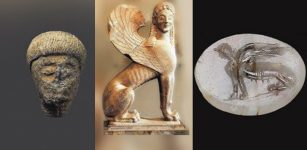Herostratic Fame Relates To Herostratus Who Burned The Beautiful Temple Of Artemis To Become Famous
Ellen Lloyd - AncientPages.com - Some people will do anything to become famous, and the ancient Greek arsonist was certainly determined to put his name in the history books. His deeds coined the term Herostratic fame, which means “fame sought by criminal or otherwise disreputable means."
Today, considered a madman by many historians, Herostratus, also called Erostratus, failed to achieve honor and status in Ephesus.
We can only guess what kind of thoughts he had, but his actions resulted in the destruction of the beautiful temple of Artemis in Ephesus, one of the Seven Wonders of the ancient world.
The Library of Celsus, Ephesus Turkey. Image credit: lensnmatter - CC BY 2.0
Situated on the Hellenized coast of Asia Minor, near present-day Selcuk, Turkey, Ephesus was one of the great cities of the Mediterranean.
King Croesus of Lydia built the Temple of Artemis to replace an older site destroyed during a flood and honor a local goddess conflated by the Greeks with Artemis, their goddess of the hunt, the wild, and childbirth. The Ephesian Artemis, the "great mother goddess," was extremely popular in ancient times.
On July 21, 356 BC, Herostratus set fire to the Temple of Artemis in his quest for fame. The temple was constructed of marble and is considered one of the most beautiful buildings in the world.
Herostratus was aware that he could not do much damage to the marble itself. However, if he could get to the wooden furnishings inside the temple, he would have a great chance of success. Instead of fleeing the scene, Herostratus was boastful about his deed.
Herostratus proudly claimed the credit in an attempt to immortalize his name in history. He surrendered to the temple authorities and was imprisoned.
Reconstruction of the Temple of Artemis. Credit: Cafeennui - CC BY-SA 3.0
To dissuade similar-minded fame-seekers, the Ephesian authorities executed him and condemned him to a legacy of obscurity by forbidding the mention of his name under penalty of death.
This did not stop Herostratus from achieving his goal because his name is still remembered and lives on in classical literature. An ancient historian named Theopompus recorded Herostratus’s arson in his book Hellenic. The arsonist’s name that the Ephesians had tried to erase has thus been preserved to this day.
Reference to Herostratus and his arson has appeared in the works of noted authors such as Chaucer, Cervantes, and Sartre.
His name has become a metonym for someone who commits a criminal act in order to become famous.
In modern languages, the term “Herostratic Fame” relates to someone committing a criminal act to bask in the resultant notoriety.
If you visit Ephesus today, you can only see the ruins of the foundations of this marvelous construction of the Hellenistic Age, entirely made of marble and full of sculptured columns' capitals and shafts. This temple's most beautiful remains are exhibited today at the London British Museum.
Written by - Ellen Lloyd AncientPages.com
Updated on September 27, 2023
Copyright © AncientPages.com All rights reserved. This material may not be published, broadcast, rewritten or redistributed in whole or part without the express written permission of AncientPages.com
More From Ancient Pages
-
 Early Toilets Reveal Dysentery In Old Testament Jerusalem
Archaeology | May 26, 2023
Early Toilets Reveal Dysentery In Old Testament Jerusalem
Archaeology | May 26, 2023 -
 Late Neolithic Italians Mastered Complex Metal Technologies – New Study
Archaeology | Jan 22, 2020
Late Neolithic Italians Mastered Complex Metal Technologies – New Study
Archaeology | Jan 22, 2020 -
 What Can Medieval Skeletons Tell Us About Modern Day Pandemics
Archaeology | Feb 25, 2022
What Can Medieval Skeletons Tell Us About Modern Day Pandemics
Archaeology | Feb 25, 2022 -
 Children Of Lir And Aoife’s Curse – Celtic Legend That Inspired The Swan Lake Ballet
Myths & Legends | Feb 8, 2024
Children Of Lir And Aoife’s Curse – Celtic Legend That Inspired The Swan Lake Ballet
Myths & Legends | Feb 8, 2024 -
 Rare Sphinx Seal Belonging To Roman Emperor Discovered In India Confirms Existence Of Legendary Muziris
Archaeology | Oct 1, 2020
Rare Sphinx Seal Belonging To Roman Emperor Discovered In India Confirms Existence Of Legendary Muziris
Archaeology | Oct 1, 2020 -
 Centeotl: Lord Of Maize Who Was Revered Before The Olmecs By All Mesoamerica’s Inhabitants
Featured Stories | Feb 20, 2024
Centeotl: Lord Of Maize Who Was Revered Before The Olmecs By All Mesoamerica’s Inhabitants
Featured Stories | Feb 20, 2024 -
 Agriculture In North America Led To Changes In Age-Independent Mortality
Archaeology | Jan 24, 2023
Agriculture In North America Led To Changes In Age-Independent Mortality
Archaeology | Jan 24, 2023 -
 Kava – Astonishing Ancient Plant That Improves Emotional Intelligence Is Gaining Popularity In The Western World
Featured Stories | Mar 31, 2018
Kava – Astonishing Ancient Plant That Improves Emotional Intelligence Is Gaining Popularity In The Western World
Featured Stories | Mar 31, 2018 -
 First Peoples’ Early Migration To Australia – Influenced By Evolving Landscapes
Archaeology | May 6, 2024
First Peoples’ Early Migration To Australia – Influenced By Evolving Landscapes
Archaeology | May 6, 2024 -
 Interesting Relief Sculpture Of Pharaoh Hatshepsut Found At Swansea University
Archaeology | Mar 27, 2018
Interesting Relief Sculpture Of Pharaoh Hatshepsut Found At Swansea University
Archaeology | Mar 27, 2018 -
 How Did Vikings Worship Their Gods?
Ancient History Facts | May 25, 2016
How Did Vikings Worship Their Gods?
Ancient History Facts | May 25, 2016 -
 Mysterious Voynich Manuscript Was Written In Two Languages – Scientists Say
Archaeology | Apr 24, 2017
Mysterious Voynich Manuscript Was Written In Two Languages – Scientists Say
Archaeology | Apr 24, 2017 -
 Master Kong Confucius: Great Philosopher And ‘Teacher Of All Teachers’ Ahead Of His Time
Featured Stories | Nov 25, 2016
Master Kong Confucius: Great Philosopher And ‘Teacher Of All Teachers’ Ahead Of His Time
Featured Stories | Nov 25, 2016 -
 Nicolas Bourbaki: The Greatest Mathematician Who Never Was
Featured Stories | Dec 24, 2019
Nicolas Bourbaki: The Greatest Mathematician Who Never Was
Featured Stories | Dec 24, 2019 -
 History Shows: Taxes And Bureaucracy Are Cornerstones Of Democracy
Archaeology | Feb 18, 2021
History Shows: Taxes And Bureaucracy Are Cornerstones Of Democracy
Archaeology | Feb 18, 2021 -
 Rare Medieval Painting Depicting Judas’ Betrayal Of Christ Saved By Reformation ‘Recycling’
Archaeology | Nov 27, 2015
Rare Medieval Painting Depicting Judas’ Betrayal Of Christ Saved By Reformation ‘Recycling’
Archaeology | Nov 27, 2015 -
 Mama Quilla – Incan Moon Goddess Of Marriage And Fertility Assisted By High Priestesses Of Qoricancha
Featured Stories | Jun 15, 2020
Mama Quilla – Incan Moon Goddess Of Marriage And Fertility Assisted By High Priestesses Of Qoricancha
Featured Stories | Jun 15, 2020 -
 Surprising New Insights Into Use And Increased Production Of Pottery At The End Of The Last Ice Age
Archaeology | Mar 22, 2016
Surprising New Insights Into Use And Increased Production Of Pottery At The End Of The Last Ice Age
Archaeology | Mar 22, 2016 -
 Strange Case Of The Italian Doppelganger – Collision Of Parallel Timelines? Part 2
Featured Stories | Oct 16, 2019
Strange Case Of The Italian Doppelganger – Collision Of Parallel Timelines? Part 2
Featured Stories | Oct 16, 2019 -
 On This Day In History: Edict Of Pistres ‘A New Law’ Against Viking Raids Issued – On July 25, 864
News | Jul 25, 2016
On This Day In History: Edict Of Pistres ‘A New Law’ Against Viking Raids Issued – On July 25, 864
News | Jul 25, 2016


